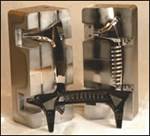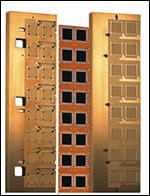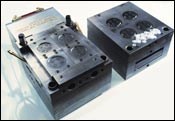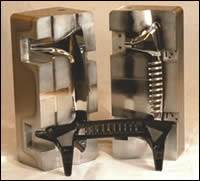Selective Materials Strategy Is A Potent Tool for Moldmakers
Reducing mold build costs with different steels and coatings may give North American shops more business from electronics OEMs.
Metal producers and coating suppliers have long promoted the use of specific materials to improve the economics of mold building. In using select grades of steel, aluminum and copper in fabrication, along with coatings that resist abrasion, corrosion and other process hazards, suppliers maintain that toolmakers can reduce production costs and enhance competitiveness, especially in a price-sensitive industry like electronics.
The argument seems logical in a market as changeable as electronics. The pace of product design in some areas makes molds obsolete in less than a year, and low-cost offshore competition dominates. There is, suppliers say, little reason to use steel with high Rockwell hardness (HRC) values for molds that may only be in use for months or for short-run production.
“There’s a tendency for the U.S. and European mold building industries to favor hard steels even when the business case for them doesn’t exist,” says Stephen DeHoff, Staff Consultant at Stress Engineering Services (Cincinnati, OH), which advises companies in moldmaking.
Most mold builders, in fact, prefer hard grades of steel for their ability to withstand the rigors of injection molding. A handful of grades—P-20, S7, H13 and 420 stainless—dominate. But while high hardness grades are durable and can be cut to tight tolerances, they also require long machining time, lengthy heat treatment procedures and can be difficult to weld. Specifying a metal that’s not as hard, but still suitable for a molding job could significantly reduce the price of a mold, suppliers maintain, especially since labor-related procedures account for 50 to 75 percent of final cost.
“We tell moldmakers to pick the steel that’s going to save them time and money—then they can start competing,” says Paul Britton, National Sales Manager for the Mold Products Division of International Mold Steel (IMS) Inc. (Florence, KY).
The goal, suppliers say, is to get tool builders to move beyond a “one-size-fits-all” approach to moldmaking and evaluate metals and coatings that reduce fabrication costs without affecting the quality and productivity of applications.
Yet toolmakers are generally reluctant to veer from the metals they know, mostly because of the costs they’ll incur if a problem develops. “Moldmakers are going to use what they know because they don’t want anything coming back to hurt them,” says Mike Close, President of Baron Quality Molds (Anaheim, CA). Unless a customer specifies another metal, Close has confidence in his track record with P-20 steel.
“Tool builders in the U.S. have a well-developed style and they stay with it,” notes DeHoff. “There’s not a hardheaded, calculating rationalization of the business needs of the product with the details of the mold specifications. Are we adding costs without adding value? Answering this would make a bunch of issues go away and marginally increase the amount of toolbuilding that stays in the U.S.”
Suppliers believe there might be reasons now for toolmakers to reconsider the materials they use in molds for electronic components. Chief among these is a greater ability to compete price-wise with offshore competitors, including those in China. While no one predicts a significant shift in business back to the U.S., there are indications that moldmakers can bid more effectively for all but the most basic molds by reining in costs. This factor, combined with the quality standards of U.S. shops, relatively short leadtimes (eight to 10 weeks), available capacity and ability to make design changes in days rather than the weeks it might take offshore, could result in business from OEMs that want to keep closer tabs on manufacturing operations.
Offshore Bargains May Fade
There also are OEMs concerned about product failures. Last summer’s recall of Chinese-made toys with lead paint highlighted the persistent quality concerns that dog manufacturing there. While there are first-rate moldmakers in China, problems exist in many shops regarding the quality of steel in use, the dimensional tolerances they can achieve and their lack of ability to build complex tools.
“The Chinese don’t do a lot of things well technically [in mold building],” says DeHoff. “They don’t use hardened steel for technical reasons as opposed to lifespan reasons, [cutting] tolerances are low, scrap rates are high and quality rejects are high. There are a lot more failures with Chinese products than have been reported. The companies this happens to have been good at keeping the problem under wraps.”
China, in fact, may become less attractive to many OEMs than it was. Wages and other costs are rising, companies are having a difficult time finding and retaining workers with technical and managerial skills, and the government recently passed or has proposed labor laws that would more than double taxes on foreign firms, encourage collective bargaining and make it difficult to terminate employees.
Wages in China—even for skilled workers—are still much less than in the West, and the country’s 2008 trade surplus is expected to increase by 45 percent over 2007 to a record $257 billion. Nevertheless, problems are developing. The yuan has risen 9.5 percent against the dollar in the past two years; labor costs in 2006 were up 16 percent and are forecast to rise 10 to13 percent this year; and the price of manufactured goods rose 1.2 percent since January, and 0.4 percent in July over June. Global Sources, a trade facilitator in Hong Kong, says 63 percent of Chinese manufacturers plan to raise export prices five to 10 percent on average by the end of the year.
Moreover, demographic trends like the one-child law are catching up with the workforce. The Chinese Academy of Sciences predicts labor shortages as soon as 2009.
Some experts believe that rising wages and business costs in China will have a ripple effect in the region. Technology Forecasters Inc. (Alameda, CA) says higher labor costs will loosen price restraints throughout Southeast Asia. As a result, Vietnam could emerge as a leader in the race for low-cost production in the region. Technology Forecasters believes, however, that U.S. OEMs may choose to move some mold production back to the Maquiladora area of Mexico if prices in China rise.
But even Maquiladora production may be temporary. Agitation by labor and human rights groups over low wages paid to workers there, coupled with a desire by OEMs to be viewed as good corporate citizens, could make a resumption of some mold building in the U.S. and Canada likely—especially if moldmakers improve the economics of their processes.
Some U.S. moldmakers already claim that by using state-of-the-art equipment and other advanced techniques they can build high quality molds for less money than in China. One firm cited by Britton, a specialist in automotive-aftermarket molds, can reportedly bring in a mold for $10,000 to $15,000 less than if produced in China. Britton, citing customer confidentiality, declines to identify the moldmaker beyond saying the company is in the Southeast.
Upgrading aspects of moldmaking to reduce fabrication costs, even to the point of selective materials specification, is beginning to gain traction among some tool builders. “To compete with a lot of the offshore places, you have to look at every aspect of the mold and cut back where you can,” says Tom Smith, General Manager of Fairway Injection Molding Systems Inc. (Walnut, CA).
Multiple Steel Choices
Suppliers offer a range of products for selective materials specification. Chief among these are metals and coatings that resist the aggressive process conditions of resins with reinforcements and additives, whose abrasive characteristics affect mold finish and surface details. Other materials are designed for use in components like locks, slide bodies, core pins, gibs and nozzles, based on the wear conditions and life cycles they encounter. One important category is heat dissipation during molding, with beryllium copper alloys and porous steel being the main materials offered.
Porous steel can be used as an insert in areas where there’s no easy way to vent hot gases. IMS has a grade called Porcerax II with micron-sized honeycombs that vent gases during molding. When placed in a mold as an insert near a hot spot, gases pass directly through the metal. Inserts also can be used with channels and exhaust lines bored through surrounding metal to speed heat evacuation.
According to Britton, porosity is achieved by applying a sintered powdered metal to the steel after it is formed. The pores come in sizes of 7 and 20 microns. The porosity of Porcerax II is 25 percent air by volume. Benefits of the inserts include elimination of short shots due to the absence of gas from previous molding cycles, faster molding cycles and fewer quality rejects. The material also reduces or eliminates flow and knit lines.
Porcerax II has a pretreated 35-40 HRC, which can be increased to 50 to 52 with heat treatment. The steel is easily polished and machined, though it requires special handling and finishing. Machining, for example, crushes the topmost layer of pores, but this can be fixed with EDM, which burns off the top layer and restores the honeycomb structure to its full venting capability.
One technique for thermal management is placing inserts of copper alloy in mold cavities and on components like hot runner nozzles and manifolds. Among companies supplying this metal is Brush Wellman Engineered Materials (Cleveland, OH), whose grades include MoldMAX HH, an alloy of 98.2 percent copper and beryllium. The 40 HRC grade has thermal conductivity that’s claimed to be almost four times greater than P-20 steel, six times higher than 420 stainless and roughly equivalent to some grades of aluminum. The result, says Doug Veitch, Director of Global Industrial Products, is fast mold cooling and reduced cycle times.
Veitch says the grade can be textured and polished. It resists abrasion when treated with a hard coating like Armoloy, a chrome material from Armoloy Corp. (DeKalb, IL), grades of which range from 78-98 HRC. The MoldMAX HH alloy has been specified for one undisclosed manufacturer’s plasma TV frames, where its thermal properties reduce warp and sink marks in the corners and yield faster cycle times.
Among the materials moldmakers are using to offset the aggressive processing conditions of some resins is Elmax, a through-hardened, corrosion-resistant, powder-metallurgy stainless steel alloy from Bohler-Uddeholm Corp. (Rolling Meadows, IL). Smith of Fairway Injection Molding Systems says the grade’s main benefit is hardness—58 HRC—which, with the addition of chromium, vanadium carbide and molybdenum, makes it extremely wear resistant, and ideal for use in inserts.
Bohler-Uddeholm claims the grade outperforms 440C stainless steel, due to its uniformity of composition in all directions. The material also has a high degree of dimensional stability and compressive strength. It is formulated for high volume molding of engineering plastics containing high levels of reinforcements, additives and fillers. Among the electronic parts it is recommended for are integrated circuits, connectors, resistors and switches.
Another stainless steel Bohler-Uddeholm developed for chemically aggressive resins is M303 Extra. The martensitic grade is highly corrosion-resistant due to its chromium (14.5%) and molybdenum (1%) content, and is formulated to outperform 1.2316, another high chromium steel. The company says the homogeneity of M303’s chemistry yields a major advantage over 1.2316, in that no delta ferrite forms in the matrix. Mechanical properties like fracture resistance are thus unaffected. M303 is pre-hardened to 32-36 HRC. It is wear-resistant, easily machinable and can be polished. It is primarily for prototyping and for short and medium production runs.
When it comes to steels designed solely for mold bases, Edro Engineering (Walnut, CA) claims its RoyAlloy grade offers a number of benefits over 420F stainless steel. These include more consistent levels of uniformity and hardness, improved dimensional stability during machining and molding, higher ductility, reduced brittleness, and better plate surface and appearance. Repairs are simplified by the steel’s high degree of weldability. The pre-hardened steel comes with a 32-36 HRC that can be raised to 40.
The grade, also a martensitic, isn’t new—it’s been available for a decade, says Mike Guscott, Vice President. But its development reflected current efforts at upgrading the economics of mold fabrication through the use of select materials that meet the needs of individual applications. In this case it was high cavitation molds. Guscott says Edro developed RoyAlloy to be a higher-performing alternative to 420F stainless grades in this area. Market acceptance has been positive, with the material accounting for a major share of the company’s stainless steel sales in the U.S.
Coatings Meet Many Needs
Moldmakers can upgrade the performance of their steels with coatings that resist wear and corrosion, enhance longevity, improve molding operations like injection and part ejection, and eliminate the need for topical application of mold-release agents.
These properties are among the advantages claimed for Balinit Arctic coatings from Oerlikon Balzers (Elgin, IL). The materials make up a line of PVD (physical vapor deposition) nitride coatings whose chief benefit is application at temperatures of 200°C, half that of conventional PVD processes. Oerlikon Balzers developed an arc evaporation technique that coats mold steels and copper alloys at low temperature. The normal temperature range is 400-450°C, says Dwayne Douglas, Product Manager for Molds and Die Casting.
There are three grades in the line: Balinit A, Balinit D and Balinit Futura Nano. Douglas believes that in addition to the benefits cited, these coatings can increase the quality and productivity of molds, and add to a moldmaker’s competitive advantage. “Molders are looking for quality and cost-savings,” he says. “Their costs are primarily due to downtime, defects and mold maintenance. If a moldmaker can offer a superior engineered product that slashes bottom-line losses, the battle is won.”
Coatings that increase hardness are ideal for thinwall mold components, textured components and almost any area of a mold exposed to aggressive resins or harsh processing conditions. Bales Mold Service (Downers Grove, IL) has been promoting the ability of its NIBORE electroless coating to upgrade the strength and performance of mold components. It can, in fact, be used to reduce wall stock with no loss of strength.
NIBORE is described as a nickel phosphorous coating with boron nitride particles in a co-deposited nickel matrix. What this means is that it achieves a 54 HRC after coating, which can be expanded to 67 HRC with heat treatment, near that of a hard chrome coating. The coating, usually applied as a 0.0005-inch deposit, enhances abrasion- and wear-resistance and lubricity, says Harry Raimondi, Technical Services Manager. This is due to its low coefficient of friction—0.05. The coating is applied at 85°C, and has an operating range of -184 to 677°C.
Summary
The electronics market has demanding engineering needs and heavy cost pressures. The shift of so much mold building offshore attests to the economics that drive the market. The rising price of manufacturing in China, however, coupled with persistent concerns about quality and time-to-market delays are creating some openings for North American moldmakers. Those looking for a share of the marginal increase in business that this could yield will find that a selective materials strategy is as important as engineering know-how and the latest fabrication equipment.
Related Content
Reasons to Use Fiber Lasers for Mold Cleaning
Fiber lasers offer a simplicity, speed, control and portability, minimizing mold cleaning risks.
Read MoreHands-on Workshop Teaches Mold Maintenance Process
Intensive workshop teaches the process of mold maintenance to help put an end to the firefighting culture of many toolrooms.
Read MoreQuestions and Considerations Before Sending Your Mold Out for Service
Communication is essential for proper polishing, hot runner manifold cleaning, mold repair, laser engraving and laser welding services.
Read MoreLine Width vs. Depth Ratio in Laser Engraving
A laser does not produce 90-degree sidewalls. It requires a certain amount of draft in order to produce the required pattern.
Read MoreRead Next
Coatings and Finishes for Electrical and Electronics Molding
Electrical and electronic components take many forms and functions and require special attention when considering surface treatment options.
Read MoreAre You a Moldmaker Considering 3D Printing? Consider the 3D Printing Workshop at NPE2024
Presentations will cover 3D printing for mold tooling, material innovation, product development, bridge production and full-scale, high-volume additive manufacturing.
Read MoreHow to Use Strategic Planning Tools, Data to Manage the Human Side of Business
Q&A with Marion Wells, MMT EAB member and founder of Human Asset Management.
Read More
























